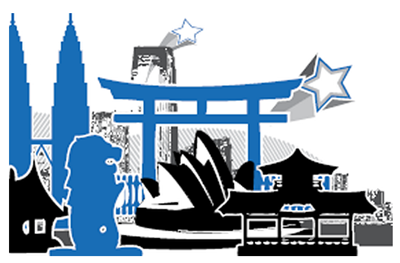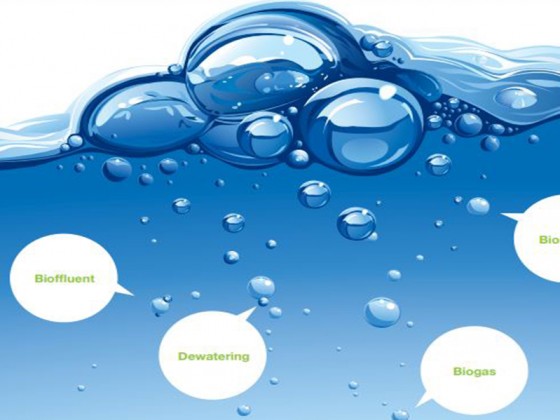Its Result To Decision Makers
by | Claudio Chauke Nehme1,2, Marcio de Miranda Santos1, Lelio Fellows Filho1, Gilda Massari Coelho1
1-Centre for Strategic Studies and Management (CGEE)
2-Catholic University of Brasilia
This article is an excerpt from the original paper entitled “The Challenges of Communicating the Foresight Study Outcomes to Better Advise Decision Makers in Policy and Strategy Matters”.
The paper was presented during the Fourth International Seville Conference on Future-Oriented Technology Analysis (FTA) and Grand Societal Challenges in Seville, Spain on the 12-13th May 2011.
The Center for Strategic Studies and Management – CGEE is a non-profit Brazilian think tank, created in 2001 and qualified as a Social Organization by the Brazilian President, and supervised by Ministry of Science and Technology, in order to promote Science, Technology and Innovation (ST&I) development to advance economic growth, competitiveness and well-being in Brazil. The scope of CGEE’s activities covers three integrated themes: foresight studies; strategic evaluation of large programs and projects; and information and knowledge diffusion related to the Brazilian ST&I System. CGEE is considered an interface organization in the ST&I environment. It has the responsibility of articulating Government, Private Sector, Academia, and other relevant ST&I representatives in the sense of gathering collective understanding to develop its activities.
From 2001 to date, CGEE has conducted nearly 400 foresight studies and program/project evaluations, mobilizing more than 2000 experts per year coming from 300 institutions.
This article addresses the challenges of communicating the results of foresight processes to Brazilian decision makers in a way that truly supports their decisions. It stresses the role of intangibles as a central outcome of foresight exercises and the importance to promote out-of-the-box thinking. Lessons learned are presented as well as a case study.
Out-of-the-box thinking in foresight exercises
The concept of out-of-the-box thinking adopted by CGEE is related to the Learning Organization Theory (Tosey, 2005). The idea is to establish an oriented process aiming at making decisions or sharing perceptions, free of prejudices, cultural influences, and reasoning processes. This concept requires that experts and other stakeholders think about new possibilities and collectively foresee related approaches, imagine influences and impacts regarding a specific issue. The mindset revision with experts and stakeholders uses mainly qualitative approaches.
Intangibles
High importance and attention is given to the generation of intangibles along the development of strategic foresight exercises. The process of sharing experiences, the collective learning and understanding, the creation of shared commitment on the main decisions to be taken and the shared vision on future possibilities are all intangibles to be pursued. Their value many times surpasses and complements tangible outcomes, such as reports and publications, as they are usually absorbed as knowledge by those participating.
Methodological Approach
There are some key elements embedded in CGEE’s methodological approach. First and most important, stakeholders must be involved in the exercise from the very beginning. They must feel comfortable and confident to participate in all phases, irrespective to the complexities involved. To have them engaged, CGEE’s team must listen, interpret and understand the client’s needs, desires and preoccupations and to describe and translate – to all participants, in an understandable way – the main objectives and strategic goals taking into consideration possibilities, opportunities and different perspectives.
Second, introducing collective intelligence over all phases of the process in a systematic manner is the key for achieving success (Glenn, 2010). In other words, collaboration, interaction and communication are all important, as well as attempts to design and plan the foresight exercise with a sense of anticipation, pointing out the most difficult points and where revisions of mindsets are expected.
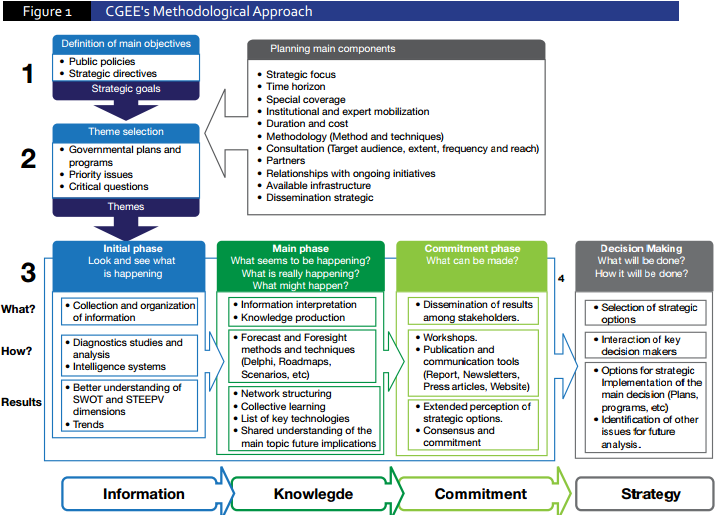
The foresight exercises conducted by CGEE comprise three distinct phases, as seen in Figure 1. The Initial Phase establishes the baseline of the exercise, usually mapping what is going on related to the main issue. The Main Phase is where most interpretation of information takes place and creativity is required at the best of the participant’s capacity. Studies, scenario planning, workshops, and electronic tools are applied, among others, in order to revise and transform mindsets, understand possible futures associated to the main issues. In this phase, CGEE intends to build a good decision-making process, making it as comprehensive as possible. In the Dissemination Phase the main recommendations are fine-tuned with decision makers in all their aspects and an implementation strategy is first designed.
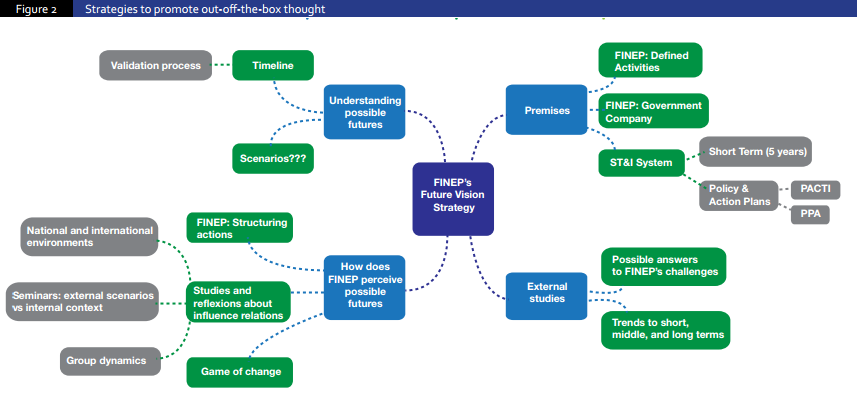
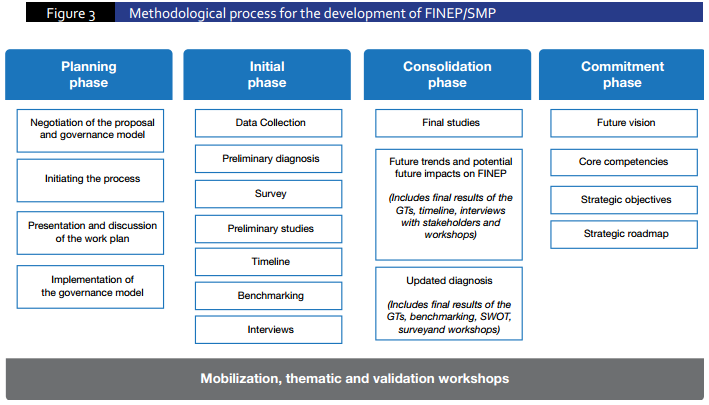
The construction process, shown in Figure 3, was participatory and involved internal and external stakeholders in a continuous process of value addition to the information obtained in the process, always searching for consensus among the participants at the various stages of the process.
The planning phase included defining the strategic management plan methodology and governance model for managing the process, motivating and mobilizing the workforce.
Some premises oriented the proposal:
• Participatory process – the involvement of managers, employees, experts and stakeholders in all stages of the process.
• Commitment by the senior management, regarding the process, the methodology and the results obtained.
• Strategies focused on prospective vision and on the definition of strategic guidelines covering horizons of 5, 10 and 15 years.
• Thinking out-of-the-box, with the stimulus to do different things differently.
• Governance model built to contribute to the development of the plan, validation and application of results and with clear attribution of responsibilities between the parties.
The methodological approach assured, through the participatory process, the commitment of an expressive contingent of internal and external stakeholders – around three thousand people-, not only with the process, but also – and mainly – with its continuity.
This represents an important intangible gain, where the process was as important as the outcomes. Strategic foresight proved to be a powerful instrument for long-term planning, counting on a diversity of methods and techniques and, above all, having flexibility and resilience in its application which enabled its adaptation to the specific needs of the study.
The principle of participation that generates commitment and the use of methods that rely simultaneously on evidence, creativity, expertise and interaction, conferred methodological robustness to the process and provided quality to the results.
Lessons learned
The case study presented, as well as others prepared by CGEE, identified three types of decision makers: government, corporate, and academia.
Their different perspectives must be taken into consideration during the development of the foresight study and when communicating its results. Preparation and delivery timing vary substantially among government, corporate and academia clients, so it is very important to be aware and respect their timing.
First, the Government sector usually desires to make decisions when some problem or urgent situation emerges from the policy environment. The sense of timing is related to the sense of opportunity so as to create initiatives and projects in the course of a government mandate. The main challenge is to introduce a long-term perception and analysis to elaborate strategic foresight for the interest of the State.
Second, in the corporate sector, in general, there is doubt about the importance of long-term strategies. The sense of timing is driven by the necessity of urgent decision-making. An aptitude can be noted for a competitive intelligence approach rather than strategic foresight. But, on the other hand, when a strategic foresight starts to make sense, this kind of stakeholder usually invests in getting involved in the foresight exercise and, afterwards, becomes one of the most active decision makers and takes advantage of the foresight outcomes.
Last, the Academia circle has strong barriers in accepting strategic foresight conduction. In this case, time is not a problem; the scientific and methodological rigor is more important and it is crucial to get this kind of stakeholder involved. After this first moment, the strategic foresight exercise becomes an extremely gratifying activity.
In concluding, the Foresight exercises are usually exposed to some dangerous traps or milestones along their applications. In order to avoid these situations, it is important to note some characteristics related to each group:
• Government representatives frequently start making decisions before interpreting what was obtained in the first phase (information and data gathering), as discussed before.
• Corporate executives may have difficulties thinking beyond their business. Foresight exercises and innovation strategies are interconnected and it is important to stress the possible influence and impacts from other business segments.
• Academia often has difficulties thinking beyond disciplinary structures. Due to a long disciplinary tradition of research and learning in the academic world, when foresight exercises and innovation strategies are applied to new future possibilities in academia, huge efforts of mindset revision and transformation are needed.


